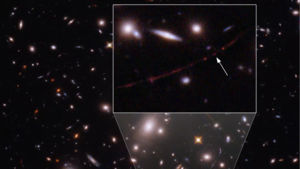Earendel: Difference between revisions
Jump to navigation
Jump to search


George Swan (talk | contribs) (first draft) |
George Swan (talk | contribs) (more details) |
||
| Line 2: | Line 2: | ||
[[File:Earendel, a star 12.9 billion light years from planet Earth.webp | thumb | "The most distant star yet seen, called Earendel, is indicated by an arrow in the inset of this image from the Hubble Space Telescope that captured the star from 12.9 billion light-years away using a gravitational lens. (Image credit: NASA, ESA, B. Welch (JHU), D. Coe (STScI), A. Pagan (STScI) )"<ref name=Space2022-03-30/> ]] | [[File:Earendel, a star 12.9 billion light years from planet Earth.webp | thumb | "The most distant star yet seen, called Earendel, is indicated by an arrow in the inset of this image from the Hubble Space Telescope that captured the star from 12.9 billion light-years away using a gravitational lens. (Image credit: NASA, ESA, B. Welch (JHU), D. Coe (STScI), A. Pagan (STScI) )"<ref name=Space2022-03-30/> ]] | ||
On March 30, 2022, Astronomers using the [[Hubble Space Telescope]] announced they had found a star they dubbed '''Earendel''' that was 12.9 billion light-years from [[Planet Earth]].<ref name=Space2022-03-30/> At 12.9 billion light years it would be not only the most distant star yet detected, but also the oldest. | On March 30, 2022, Astronomers using the [[Hubble Space Telescope]] announced they had found a star they dubbed '''Earendel''' that was 12.9 billion light-years from [[Planet Earth]].<ref name=Space2022-03-30/> At 12.9 billion light years it would be not only the most distant star yet detected, but also the oldest. | ||
Detection of the star was possible because it was at the focus of a [[Gravitational lens]].<ref name=Space2022-03-30/> | |||
==References== | ==References== | ||
{{Reflist|refs= | {{Reflist|refs= | ||
Revision as of 11:11, 30 March 2022

"The most distant star yet seen, called Earendel, is indicated by an arrow in the inset of this image from the Hubble Space Telescope that captured the star from 12.9 billion light-years away using a gravitational lens. (Image credit: NASA, ESA, B. Welch (JHU), D. Coe (STScI), A. Pagan (STScI) )"[1]
On March 30, 2022, Astronomers using the Hubble Space Telescope announced they had found a star they dubbed Earendel that was 12.9 billion light-years from Planet Earth.[1] At 12.9 billion light years it would be not only the most distant star yet detected, but also the oldest.
Detection of the star was possible because it was at the focus of a Gravitational lens.[1]
References
- ↑ 1.0 1.1 1.2 Charles Q. Choi. Hubble Space Telescope spots most distant single star ever seen: Meet Earendel, a star 12.9 billion light-years from Earth, Space.com, 2022-03-30. Retrieved on 2022-03-30.